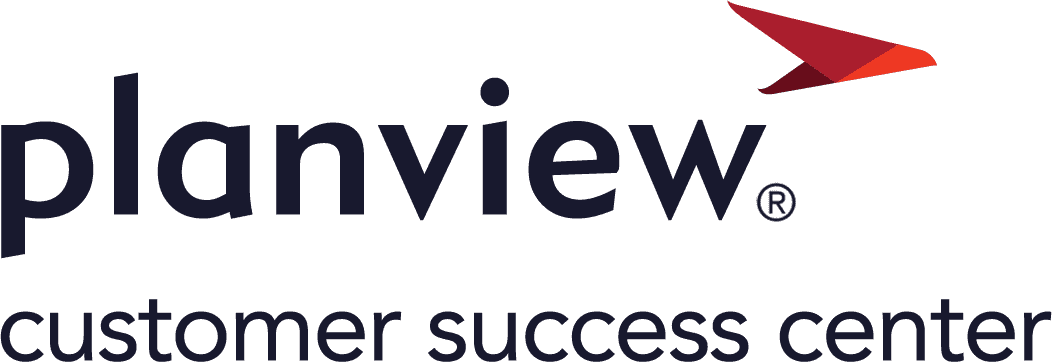Portfolios process flows
Overview
This guide provides an in-depth walkthrough of how organizations can use Planview Portfolios to support initiative planning and strategic alignment. Learn how to define strategic goals, create and categorize initiatives, assign budgets, and track progress against business outcomes. Whether you're building a strategic structure or evaluating performance with dashboards, you'll find the processes, reports, and best practices needed to turn strategy into action.
Process steps

| Process step | Description |
|---|---|
|
Define strategic goals or funding structure |
The Strategy structure is used to manage the initiatives and programs that will deliver the strategic plan of the organization. Customers typically define the strategic structure in one of two ways:
See Strategies for more information To access the Strategy Portfolio View go to Strategy Portfolio View Screen Basics. Strategy structure levels are determined by the core implementation team and our core consulting team, based on your business needs. Once the levels are determined, users and Planview administrators can add strategic entities to the respective levels. To add a new investment/strategic entity, click the +New option on the action menu at its parent level. Action menus are used to either perform an action or to navigate to a different view. The action menu lets you easily build out the structure using +New. If the child only has one label option, that option is dynamically displayed (+New Objective for example). If not, Strategy Type will have an option list for the header type on the next screen. Tip! The +New menu at the top of the screen will allow users to add to the Strategy structure, but the user will also have to define the strategic parent for the new entity. See Creating a Strategic Entity for more information |
|
Describe and categorize strategies |
The purpose of this step is to describe and categorize the strategies in the portfolio, by populating the relevant data entry screens. This information can be used to filter or slice analytics downstream in the reporting output process or divide strategic information in to relevant portfolios based on these data points. See Modifying a Strategy Portfolio's Definition for more information |
|
Create strategic initiatives |
Following the creation of the Organizational Strategic Goals or Funding Structure, the next step is to create the initiatives that will contain the programs to deliver the work. The first step in adding a new investment is to complete the Basic Information screen. Example of Adding a New Initiative: When adding a strategic entity, users will be presented with a Basic screen. Let’s review what some of these fields are for. 1. The strategic parent will be automatically populated based on the level you selected to add the entity to. 2. The new entity will be added at a level below the selected entity. Up to 50 characters are allowed for each description. 3. The strategic and investment approval statuses will be defaulted to the value set for your solution. Depending on your solution for strategic lifecycles, these values may be updated from the Strategy View or they may be updatable only via the lifecycle or from the Investment and Capacity Manager screen. 4. The target date entered here will be displayed on the Strategy View. 5. The Lifecycle options may be available to selected, if lifecycles are enabled for the level. 6. The user adding the entity will be automatically listed as the lifecycle administrator if the user has the appropriate permission. If not, users can select someone from the list. See Lifecycles for more information. |
|
Describe and categorize initiatives |
Creating a new initiative will likely include the population of a small amount of (configuration-specific) description and categorization attributes as determined by the data and information needs of the organization. |
|
Create/manage relevant financial targets and budget |
Build out the elements of the financial plans so that these budgets can be used to fund programs or the allocated work. Define an organization-wide strategic investment budget that will eventually be divided out between the relevant initiatives and programs, acting as the baseline for comparison against the actual cost of delivery. Organization-wide investment budgets can be defined in the financial plan at any level of the investment/strategy structure. The budget can be assigned to different business units or strategic programs, based on the investment/strategy structure. Planview Portfolios supports both the top-down and bottom-up strategic budget planning. For top-down planning, budgets can be assigned to a level of the strategy structure on the Financial Planning Detail screen, then spread down to lower levels. For bottom-up planning, budgets are captured at the lower levels and can be summarized or rolled up to the higher levels. Click here for bottom-up approach. Click here for top-down approach. For more information: |
Reports
How are we able to understand the strategic direction of the organization?
|
FastTrack Power BI Showcase Dashboards – Strategy – Strategy Portfolio Balance |
Power BI Dashboard |
This dashboard counts the strategic initiatives and programs in select portfolios by the line of business, sponsorship, and initiative drivers. You can slice data by portfolio and view an overall status assessment for each project. |
|
Strategy Portfolio – Portfolio Manager – Customizable Column Set |
Tile |
This allows you to see strategy data in a customizable column set, including roadmaps, financials, effort, and more. |
|
Analytic |
This report summarizes key data points relating to the investment programs of the organization. The report can be configured to show specific attributes, fields, dates, and financial plan measures associated with each strategic entity. |
|
|
Analytic |
This report provides you with a count of the strategic initiatives or programs in a portfolio, allowing analysis by a primary and secondary attribute. |
|
|
Analytic |
This bubble chart plots prioritization, cost, benefit, revenue, and effort measures against strategic initiative or program status dimensions. For example, it can provide a value vs. cost visualization of the portfolio pipeline to show lifecycle stage and strategic alignment. |
|
|
Analytic |
This report shows data on program approval to help you analyze throughput, volume, and cycle time. You can adjust the report parameters to change the grouping and time horizon. |
How are we able to understand who is responsible for the strategic plan?
|
Strategy Portfolio – Portfolio Manager – Customizable Column Set |
Tile |
This allows you to see strategy data in a customizable column set, including roadmaps, financials, effort, and more. |
|
Analytic |
This report summarizes key data points relating to the investment programs of the organization. The report can be configured to show specific attributes, fields, dates, and financial plan measures associated with each strategic entity. |
|
|
Analytic |
This one-page report provides an executive summary of key program information for program stakeholders followed by detailed reports, including:
This report can be run for a single program or a portfolio. |
Best practices
Focus on transformation
Although it may seem like any other organizational hierarchy at the surface level, simply using initiatives to tie projects and programs together is not enough. Initiatives must deliver on strategy by transforming the business outcomes through underlying projects and programs.
Invest in your strategic structure
To achieve strategic objectives, the initiatives, programs, and projects must be organized efficiently and thoughtfully to support one another in an effective strategic structure. Invest time thinking through this structure, identifying opportunities for connection and collaboration at all levels.
Be proactive, not reactive
Many organizations or parts of organizations live in a reactive model, and when switching to an initiative-based model, just fill their initiatives with the reactive model they have in place. This defeats the purpose of initiatives entirely, which is to make intentional decisions about what to invest time and money into.
Find a financial planning balance
There has been much said in the debate about top-down and bottom-up financial planning. In practice, it is often best to use a combination of the two, allowing for organic planning from those on the ground but also intentional decision-making on investments for those at the top. Find the right balance between the two so you have the best of both worlds.
Ensure access to data
At the initiative level having access to all relevant data is more crucial than ever. Ensure all internal and external data is put together into easy-to-read reports or dashboards, especially data coming from underlying programs and projects. Access to this data will allow for quickly changing course as needed.
Plan for change
The world we live in and the ways we do business are changing faster than ever before. Good initiative owners will be ready to assess and reassess to quickly pivot when there is a need. Consider implementing a regular process with key decision makers to continually assess whether initiatives are still relevant and aligned with market dynamics.
Align management on decisions
For the initiative model to work, the entirety of the management team must be on the same page. Ensure the entirety of your management team is both informed and on board when it comes to new decisions being made, so they can continue to effectively drive the transformation within their own realm.
Create roadmaps
Roadmaps are a great tool for easy visualization of the strategic plan that includes a tangible timeline with key tasks. Roadmaps go hand-in-hand with initiatives as they help with both keeping the initiatives on track, as well as being able to easily show progress for key stakeholders or decision makers.
Monitor demand and capacity
While it’s important as an initiative manager not to get too in the weeds, it is also crucial to stay on top of demand and capacity to ensure initiative work is effectively prioritized and that key resources are not being pushed to burn out. Keep up to date on this information and be ready to adjust as things change.

